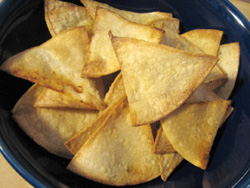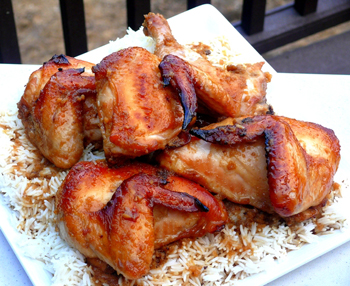 Corn tortillas come in such huge bags, I don't know how can you possibly use them all. Buying one of those packages, though they are cheap, is a major commitment in my house. It means weeks of enchiladas, tacos, chilaquiles and when I run out of ideas, tortilla chips or totopos as they are known in Mexico. I love the word totopos, even though it sounds a bit too much like the Italian name of a certain well-known cartoon mouse.
Corn tortillas come in such huge bags, I don't know how can you possibly use them all. Buying one of those packages, though they are cheap, is a major commitment in my house. It means weeks of enchiladas, tacos, chilaquiles and when I run out of ideas, tortilla chips or totopos as they are known in Mexico. I love the word totopos, even though it sounds a bit too much like the Italian name of a certain well-known cartoon mouse.
Traditionally totopos are tortillas cut into triangular wedges that are deep fried in oil. If there is one thing I just can't bring myself to do, it's deep fry anything in oil. I just can't. Don't ask me. So here is what I do instead, I bake the tortillas. Baking doesn't make them as light, crispy and decadent as frying, but they are still yummy and as a bonus you can enjoy them with very little guilt.
If you look for tortilla chips in the store, you'll find they come in all kinds of flavors. With a little experimenting I found you can make great lime and salt flavored chips with--you guessed it, lime and salt! Eat them plain, with salsa or with toppings like guacamole, refried beans and crumbly Mexican cheese. Are you getting hungry yet? Because I sure am.
Global Cuisine
Global Cuisine
Indonesian Ginger Chicken
 I am always searching for
a new way to make chicken. It's one of those blank canvas foods...just
waiting for inspiration to hit and turned into something wonderful.
I am always searching for
a new way to make chicken. It's one of those blank canvas foods...just
waiting for inspiration to hit and turned into something wonderful.
While flipping through one of my Ina Garten cookbooks, I came across this recipe. There wasn't a picture, which often deters me from making something. I want to see it done. Anyway, it just sounded good, not to mention I had few hunks of ginger in the refrigerator I needed to use. Ina mentioned this was served in her New York store and was excellent both warm and cold.
The mixture of the honey, ginger, garlic and soy sauce sounded like the perfect flavor combination. So out came the chickens from the freezer to thaw completely and then the marinating process began.
Sweet-Tangy Plum-Spiced Chicken
 I call this the 1-2-3 dinner because just like that, snap, and it's ready.
I call this the 1-2-3 dinner because just like that, snap, and it's ready.
On the way home yesterday, after spending the afternoon at a museum with my boys, my eight-year old begged me to make this for dinner. It's one of his favorite meals and he knows he doesn't have to wait long for me to whip this up.
"Mom, please make the 1-2-3 chicken tonight, it's soooo good. I really, really want it and it's so yummy.
So here it is, dinner in a flash, ready so fast there's even time to take pictures!
I know I saw this recipe in a magazine, however I can't remember which one. I've made it so many times, I have it memorized. I also don't remember if this dish had a name, so let's call it Tangy-Sweet Plum-Spiced Chicken, a shout out to the plum jam and Chinese five-spice powder used in this recipe.
When Neon was King
 My love affair with food began in the dim dark ages of the glorious 1990’s, when neon was king and it was cool to rock a mullet while listening to Marky Mark and his Funky Bunch. Born in San Diego and being brought up by a Hawaiian family from beautiful Kaneohe, greatly impacted my palate, and brought me to the culinary forefront well before my time.
My love affair with food began in the dim dark ages of the glorious 1990’s, when neon was king and it was cool to rock a mullet while listening to Marky Mark and his Funky Bunch. Born in San Diego and being brought up by a Hawaiian family from beautiful Kaneohe, greatly impacted my palate, and brought me to the culinary forefront well before my time.
The Hawaiian family unit is a large extended conglomeration made up of relatives and friends of the family, which basically makes dinnertime feel like riding ‘It’s a Small World’ at Disneyland, where everyone I’m not related to is either an ‘aunt,’ ‘uncle,’ or a ‘cousin.’ So in other words, it made finding a prom date that wasn’t a cousin, quite difficult. (That’s my excuse)
Our Favorite Cinco De Mayo Recipes
 |
Spicy Pumpkin Seeds – Great with beer Classic Margarita – Blending is not allowed. Lila’s Guacamole – The best way to eat green. Huevos alla Amy – A breakfast treat. Tortilla Soup - In case it's still cold in your neck of the woods. Topopo Salad – A salad of volcanic proportions. Ceviche – Cool and refreshing. Enchiladas Suizas – Simply delicious. Mexican Chicken – Spicing it up. Goat Cheese and Poblano Quesadillas with Pineapple-Habanero Salsa - For those who like it HOT! Grilled Steak Tacos with Watermelon-Mango-Jicama Salsa - It's not a celebration without tacos & salsa. |
More Articles ...
Welcome to the new One for the Table ...
Our Home Page will be different each time you arrive.
We're sure you'll find something to pique your interest...

